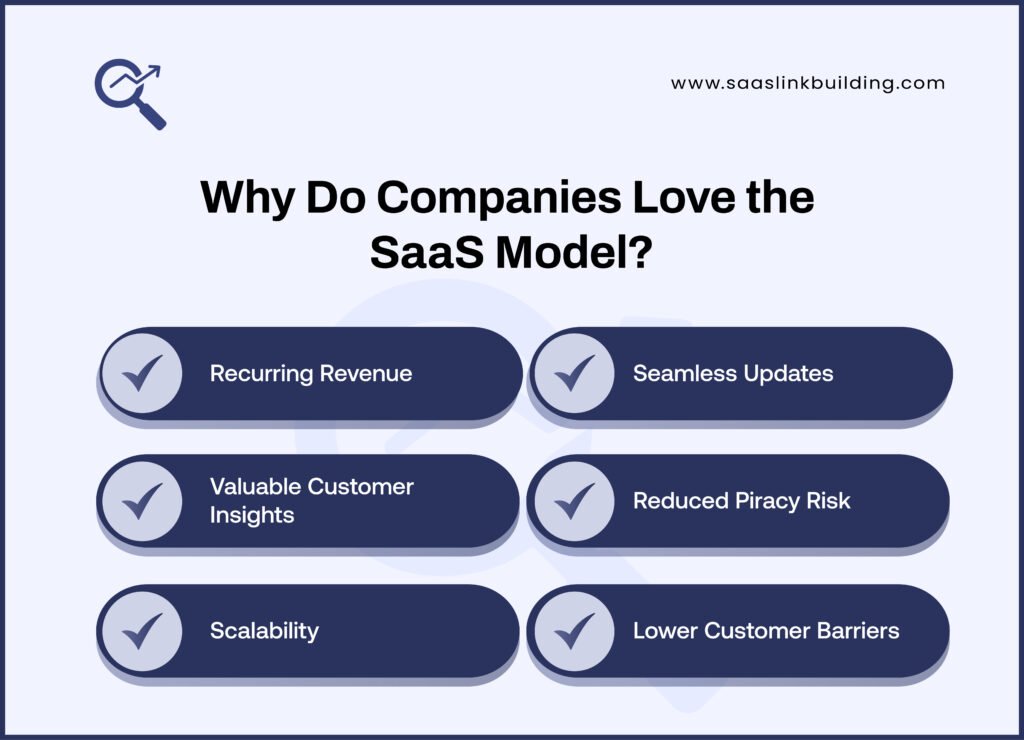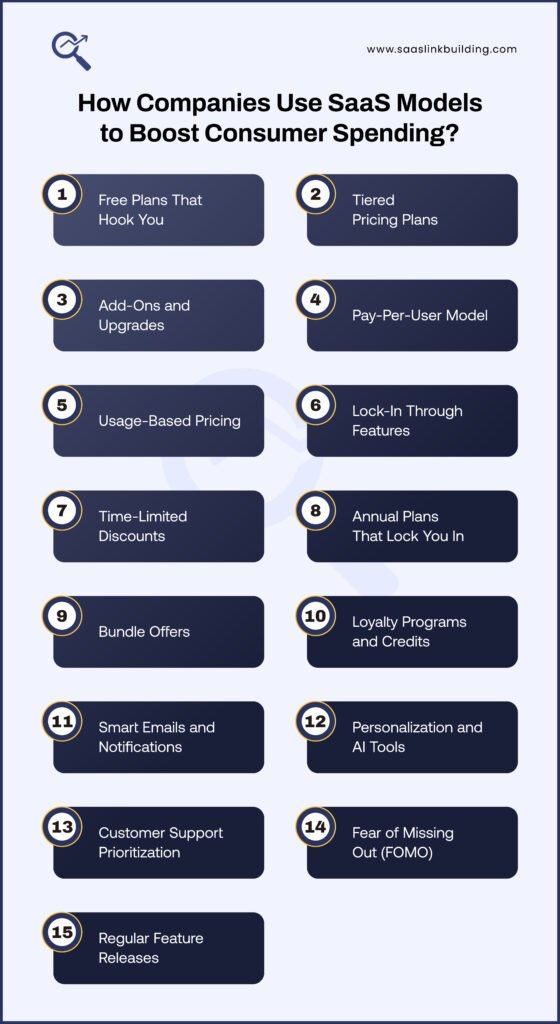Have you ever signed up for an app that seemed free but then asked you to pay for more features later? That is not a trick. It is part of how many companies use the SaaS model to make money. In this blog, we are going to talk about how companies use SaaS to get people to spend more.
We will break it down in a very simple way. Whether you are a curious user or someone thinking of starting your own SaaS business, this will help you understand what is really going on behind the scenes.
What Is SaaS?
Let us start with the basics. SaaS stands for Software as a Service. It means software that you do not buy and install. Instead, you use it online and usually pay for it every month or year.
Some examples of SaaS products include:
- Netflix (for entertainment)
- Canva (for design)
- Dropbox (for file storage)
- Zoom (for video calls)
- Shopify (for online stores)
You do not own these tools. You just use them as long as you keep paying.
Why Do Companies Love the SaaS Model?

Many companies favor the Software as a Service (SaaS) model because it provides ongoing revenue and operational advantages. Unlike traditional software that requires a one-time purchase, SaaS offers subscription-based pricing, leading to more predictable income.
Key reasons companies choose the SaaS model:
- Recurring Revenue: Subscriptions ensure consistent, ongoing income, improving financial planning and stability.
- Seamless Updates: Software is updated automatically in the cloud, eliminating the need for manual installations or downtime.
- Valuable Customer Insights: SaaS platforms collect real-time user data, helping companies understand user behavior and make informed improvements.
- Reduced Piracy Risk: Cloud-based access makes it more difficult to illegally copy or distribute the software.
- Scalability: Companies can easily scale services up or down based on demand, making SaaS cost-efficient.
- Lower Customer Barriers: Monthly or annual payments are more affordable than high upfront costs, attracting a wider user base.
Now let us see how they get you to spend more.
How Companies Use SaaS Models to Boost Consumer Spending?

Companies use SaaS models to boost consumer spending in several strategic and psychological ways. Here’s how:
1. Free Plans That Hook You
A lot of SaaS tools begin with something that looks like a gift—a free plan. No credit card needed. No payment required. You sign up and get started in minutes. It feels amazing at first.
But then, the limits start to show. You may run into things like:
- Only 1 project allowed
- No access to premium designs
- Watermarks on your exports
- No customer support or very slow replies
At first, it is okay. You are still testing. But once you start using the tool seriously, these limits get in your way. And then—boom—they offer an upgrade. It feels like the obvious next step.
This is the freemium model, and it works well because:
- You already trust the tool
- You already invested time in learning it
- You do not want to start from scratch again
This kind of upgrade is more about emotion than logic. You feel like the tool deserves your money now.
2. Tiered Pricing Plans
Almost every SaaS product comes with multiple pricing plans. These plans usually have names like:
- Basic
- Pro
- Business
- Enterprise
Each plan gives more than the one before. As you move up, you get:
- More users
- Better support
- Extra storage
- Fancy features like analytics or AI tools
But here’s the trick: these plans are not random. They are designed to nudge you toward a specific choice. Usually, the middle plan is placed right where your eyes land. It has more features than the basic one but is cheaper than the top-tier plan.
This is called “price anchoring.” You see the expensive one and think, “That is too much.” Then you see the basic one and think, “That is not enough.” So, the middle one feels just right.
3. Add-Ons and Upgrades
Once you are on a plan, that is not the end. SaaS tools often offer add-ons to help you do more. These are like toppings on a pizza. Each one is small, but they increase the final bill.
Some common add-ons include:
- Extra storage for your files
- Advanced AI-powered tools
- Priority customer support
- Access to beta features
- More customization options
These extras often feel optional. But once you hit a roadblock, you feel the need. And since it’s just a few dollars more, you add it. Over time, all these little extras grow your bill quietly.
4. Pay-Per-User Model
This is a common strategy for SaaS tools that sell to teams or businesses. The pay-per-user model means the cost grows with the number of people using the tool.
For example:
- $10 per user per month
- A 5-person team = $50/month
- A 30-person team = $300/month
It sounds simple. But as your business grows and you add new team members, your monthly cost goes up too. This model works well because:
- It matches your company growth
- It keeps the entry price low
- It scales revenue naturally
So even if the price per user feels small, the total cost can grow very quickly without you even noticing.
5. Usage-Based Pricing
Instead of charging per user, some companies charge based on how much you use their service.
Here are some examples:
- A cloud storage tool charging per GB stored
- A video hosting platform charging per number of views
- An email marketing tool charging per emails sent
This model starts off very friendly. You only pay for what you use. But as your business or audience grows, your usage grows too—and so does your bill.
These tools scale with your success. The better you do, the more you need them—and the more you pay.
6. Lock-In Through Features
Many SaaS companies design their product in a way that makes switching hard.
How?
- Your data is deeply stored in their system
- You set up custom workflows
- The tool connects with other tools you use
- You trained your team to use it
Now, even if a cheaper tool comes along, switching feels like too much trouble. This is called vendor lock-in. It’s not bad—it just makes it easier for users to stick around. And sticking around means continued payments.
7. Time-Limited Discounts
Ever seen something like this?
- “Get 50% off for your first 3 months!”
- “Sign up now and get 2 months free!”
These offers create urgency. You feel like you are getting a deal. But what happens when the discount ends?
- You are already using the tool
- You like how it works
- Moving to a new tool feels like work
So most people just continue—even at full price. These limited-time offers are designed to get you in and keep you.
8. Annual Plans That Lock You In
Many SaaS companies offer two plans:
- Monthly: $20/month
- Yearly: $200/year
The yearly plan gives you 2 months free. Sounds smart, right? And it is—for both sides. You pay more upfront, but you save long term. For the company, they:
- Get more money upfront
- Lock you in for a full year
- Reduce churn (users canceling)
Even if you stop using the tool halfway, you already paid. And that is the genius behind annual billing.
9. Bundle Offers
Some companies combine tools into one package. This is known as bundling.
Examples include:
- Google Workspace: email, cloud, docs, and more
- Adobe Creative Cloud: Photoshop, Illustrator, Premiere, etc.
- Microsoft 365: Word, Excel, Teams, Outlook
You may only need one tool, but the bundle feels like a better deal. So you end up paying more—but it feels like you are saving.
10. Loyalty Programs and Credits
To keep users around, SaaS companies sometimes use credit systems or referral rewards.
Here is how:
- Get $10 for every friend you refer
- Complete certain tasks and earn credits
- Get badges for being a long-term user
These rewards make you feel appreciated. But they also work as gentle pushes to stay longer and keep spending.
11. Smart Emails and Notifications
Ever get an email like:
- “You are running out of storage”
- “Unlock this feature by upgrading”
- “Your trial ends soon”
These messages are not random. They are triggered by your actions. You opened a feature too many times? You get an upgrade suggestion. You added a new teammate? You get a plan suggestion.
These behavioral nudges are powerful. They come at the right moment, making it more likely you will spend.
12. Personalization and AI Tools
Today, many SaaS companies use AI and analytics to understand your behavior.
They track:
- What tools you use most
- How often you use the product
- Where you get stuck
Then they show personalized suggestions like:
- “You use X a lot. Upgrade to get more features.”
- “We noticed you have a growing team. Try our Business Plan.”
These suggestions feel helpful. But they are also meant to guide you toward higher-priced plans that match your needs.
13. Customer Support Prioritization
Not all support is the same. In many SaaS companies:
- Free users get email support
- Paid users get live chat
- Premium users get a dedicated success manager
If your work depends on the tool, you do not want to wait days for a reply. So you pay more just to get faster help. And that’s exactly what companies plan for.
14. Fear of Missing Out (FOMO)
“Only 3 spots left at this price.”
“Offer ends in 6 hours.”
“New feature—limited beta access!”
These phrases make you act fast. Even if you were not planning to buy today, the fear of missing out pushes you. It feels like a rare chance, and you do not want to lose it.
This FOMO-based marketing is a classic trick—and it still works.
15. Regular Feature Releases
SaaS companies love announcing new features. Every month, there is something new:
- A new AI feature
- A better integration
- A new dashboard design
You may not even use these new things. But the regular updates create a feeling of progress. It looks like the tool is always improving, and that justifies the price in your mind.
Want to Dive Deeper into SaaS Growth and Strategy?
This blog showed how SaaS companies drive spending through smart pricing and psychology. If you want to explore how SaaS businesses attract users, build brand trust, and scale through strategic marketing, check out our complete guide to SaaS marketing strategies. It breaks everything down in simple terms—perfect if you are building your own SaaS product or just curious how the top companies do it.
Conclusion
SaaS companies are smart. They use a mix of psychology, pricing tricks, and smart design to get people to spend more. But they also bring value. The tools they offer can save time, improve work, and make life easier.
As a user, it is good to know these tricks. That way, you can decide clearly if a tool is worth your money. And if you are building your own SaaS, now you know how to structure your pricing in a way that works.
The SaaS model is not just about software. It is about understanding people, solving problems, and offering more over time. That is how companies grow. And that is how users end up spending more.
Thanks for reading!




